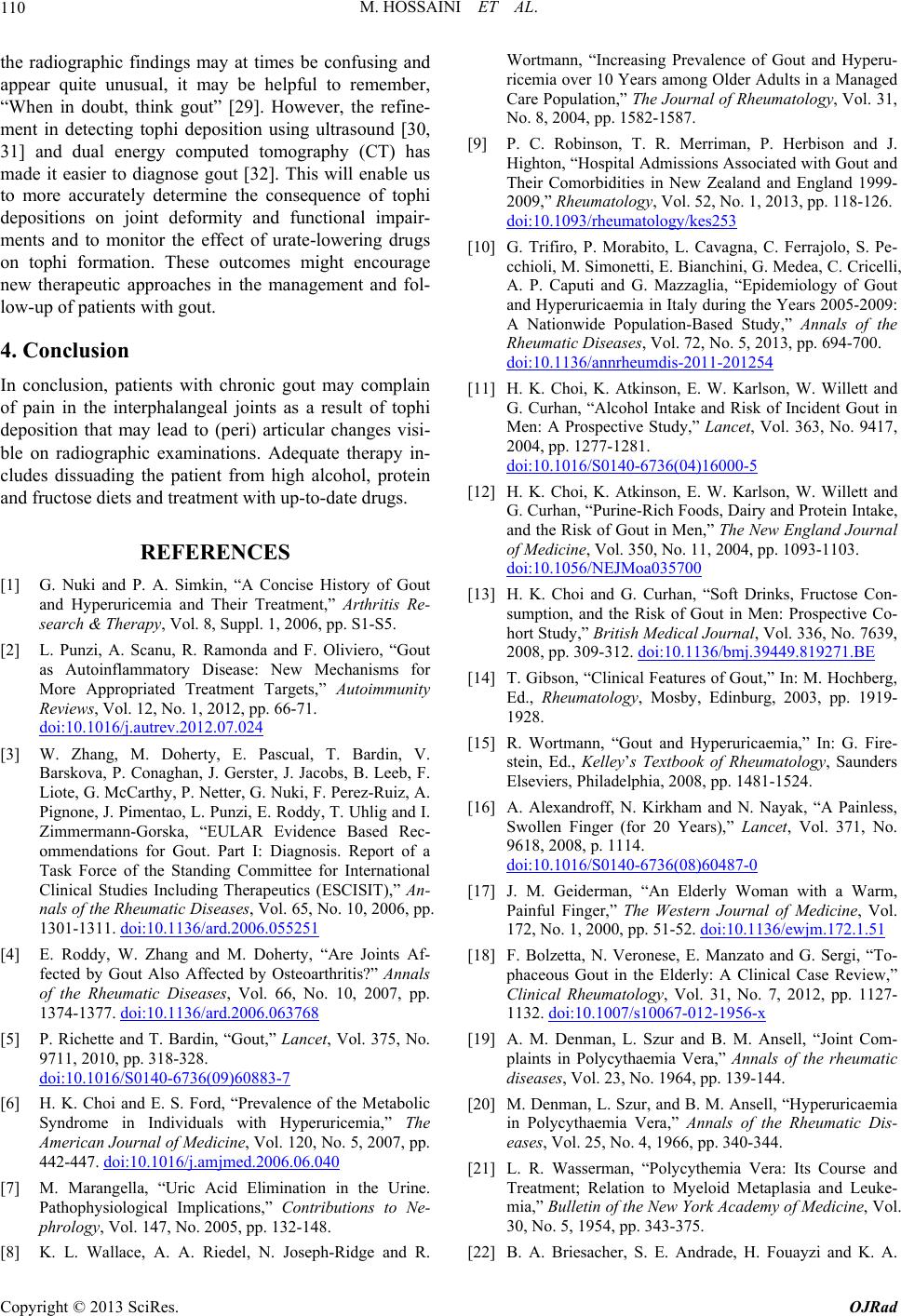
M. HOSSAINI ET AL.
110
the radiographic findings may at times be confusing and
appear quite unusual, it may be helpful to remember,
“When in doubt, think gout” [29]. However, the refine-
ment in detecting tophi deposition using ultrasound [30,
31] and dual energy computed tomography (CT) has
made it easier to diagnose gout [32]. This will enable us
to more accurately determine the consequence of tophi
depositions on joint deformity and functional impair-
ments and to monitor the effect of urate-lowering drugs
on tophi formation. These outcomes might encourage
new therapeutic approaches in the management and fol-
low-up of patients with gout.
4. Conclusion
In conclusion, patients with chronic gout may complain
of pain in the interphalangeal joints as a result of tophi
deposition that may lead to (peri) articular changes visi-
ble on radiographic examinations. Adequate therapy in-
cludes dissuading the patient from high alcohol, protein
and fructose diets and treatment with up-to-date drugs.
REFERENCES
[1] G. Nuki and P. A. Simkin, “A Concise History of Gout
and Hyperuricemia and Their Treatment,” Arthritis Re-
search & Therapy, Vol. 8, Suppl. 1, 2006, pp. S1-S5.
[2] L. Punzi, A. Scanu, R. Ramonda and F. Oliviero, “Gout
as Autoinflammatory Disease: New Mechanisms for
More Appropriated Treatment Targets,” Autoimmunity
Reviews, Vol. 12, No. 1, 2012, pp. 66-71.
doi:10.1016/j.autrev.2012.07.024
[3] W. Zhang, M. Doherty, E. Pascual, T. Bardin, V.
Barskova, P. Conaghan, J. Gerster, J. Jacobs, B. Leeb, F.
Liote, G. McCarthy , P. Netter, G. Nuki, F. Perez-Ruiz, A.
Pignone, J. Pimentao, L. Punzi, E. Roddy, T. Uhlig and I.
Zimmermann-Gorska, “EULAR Evidence Based Rec-
ommendations for Gout. Part I: Diagnosis. Report of a
Task Force of the Standing Committee for International
Clinical Studies Including Therapeutics (ESCISIT),” An-
nals of the Rheumatic Diseases, Vol. 65, No. 10, 2006, pp.
1301-1311. doi:10.1136/ard.2006.055251
[4] E. Roddy, W. Zhang and M. Doherty, “Are Joints Af-
fected by Gout Also Affected by Osteoarthritis?” Annals
of the Rheumatic Diseases, Vol. 66, No. 10, 2007, pp.
1374-1377. doi:10.1136/ard.2006.063768
[5] P. Richette and T. Bardin, “Gout,” Lancet, Vol. 375, No.
9711, 2010, pp. 318-328.
doi:10.1016/S0140-6736(09)60883-7
[6] H. K. Choi and E. S. Ford, “Prevalence of the Metabolic
Syndrome in Individuals with Hyperuricemia,” The
American Journal of Medicine, Vol. 120, No. 5, 2007, pp.
442-447. doi:10.1016/j.amjmed.2006.06.040
[7] M. Marangella, “Uric Acid Elimination in the Urine.
Pathophysiological Implications,” Contributions to Ne-
phrology, Vol. 147, No. 2005, pp. 132-148.
[8] K. L. Wallace, A. A. Riedel, N. Joseph-Ridge and R.
Wortmann, “Increasing Prevalence of Gout and Hyperu-
ricemia over 10 Years among Older Adults in a Managed
Care Population,” The Journal of Rheumatology, Vol. 31,
No. 8, 2004, pp. 1582-1587.
[9] P. C. Robinson, T. R. Merriman, P. Herbison and J.
Highton, “Hospital Admissions Associated with Gout and
Their Comorbidities in New Zealand and England 1999-
2009,” Rheumatology, Vol. 52, No. 1, 2013, pp. 118-126.
doi:10.1093/rheumatology/kes253
[10] G. Trifiro, P. Morabito, L. Cavagna, C. Ferrajolo, S. Pe-
cchioli, M. Simonetti, E. Bianchini, G. Medea, C. Cricelli,
A. P. Caputi and G. Mazzaglia, “Epidemiology of Gout
and Hyperuricaemia in Italy during the Years 2005-2009:
A Nationwide Population-Based Study,” Annals of the
Rheumatic Diseases, Vol. 72, No. 5, 2013, pp. 694-700.
doi:10.1136/annrheumdis-2011-201254
[11] H. K. Choi, K. Atkinson, E. W. Karlson, W. Willett and
G. Curhan, “Alcohol Intake and Risk of Incident Gout in
Men: A Prospective Study,” Lancet, Vol. 363, No. 9417,
2004, pp. 1277-1281.
doi:10.1016/S0140-6736(04)16000-5
[12] H. K. Choi, K. Atkinson, E. W. Karlson, W. Willett and
G. Curhan, “Purine-Rich Foods, Dairy and Protein Intake,
and the Risk of Gout in Men,” The New England Journal
of Medici ne, Vol. 350, No. 11, 2004, pp. 1093-1103.
doi:10.1056/NEJMoa035700
[13] H. K. Choi and G. Curhan, “Soft Drinks, Fructose Con-
sumption, and the Risk of Gout in Men: Prospective Co-
hort Study,” British Medical Journal, Vol. 336, No. 7639,
2008, pp. 309-312. doi:10.1136/bmj.39449.819271.BE
[14] T. Gibson, “Clinical Features of Gout,” In: M. Hochberg,
Ed., Rheumatology, Mosby, Edinburg, 2003, pp. 1919-
1928.
[15] R. Wortmann, “Gout and Hyperuricaemia,” In: G. Fire-
stein, Ed., Kelley’s Textbook of Rheumatology, Saunders
Elseviers, Philadelphia, 2008, pp. 1481-1524.
[16] A. Alexandroff, N. Kirkham and N. Nayak, “A Painless,
Swollen Finger (for 20 Years),” Lancet, Vol. 371, No.
9618, 2008, p. 1114.
doi:10.1016/S0140-6736(08)60487-0
[17] J. M. Geiderman, “An Elderly Woman with a Warm,
Painful Finger,” The Western Journal of Medicine, Vol.
172, No. 1, 2000, pp. 51-52. doi:10.1136/ewjm.172.1.51
[18] F. Bolzetta, N. Veronese, E. Manzato and G. Sergi, “To-
phaceous Gout in the Elderly: A Clinical Case Review,”
Clinical Rheumatology, Vol. 31, No. 7, 2012, pp. 1127-
1132. doi:10.1007/s10067-012-1956-x
[19] A. M. Denman, L. Szur and B. M. Ansell, “Joint Com-
plaints in Polycythaemia Vera,” Annals of the rheumatic
diseases, Vol. 23, No. 1964, pp. 139-144.
[20] M. Denman, L. Szur, and B. M. Ansell, “Hype ruricaemia
in Polycythaemia Vera,” Annals of the Rheumatic Dis-
eases, Vol. 25, No. 4, 1966, pp. 340-344.
[21] L. R. Wasserman, “Polycythemia Vera: Its Course and
Treatment; Relation to Myeloid Metaplasia and Leuke-
mia,” Bulletin of the New York Academy of Medicine, Vol.
30, No. 5, 1954, pp. 343-375.
[22] B. A. Briesacher, S. E. Andrade, H. Fouayzi and K. A.
Copyright © 2013 SciRes. OJRad